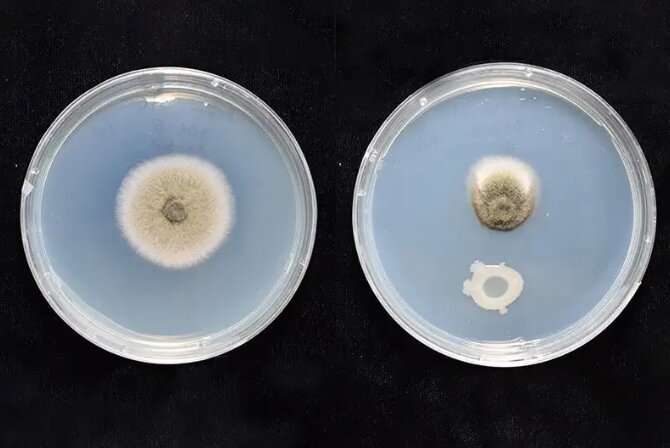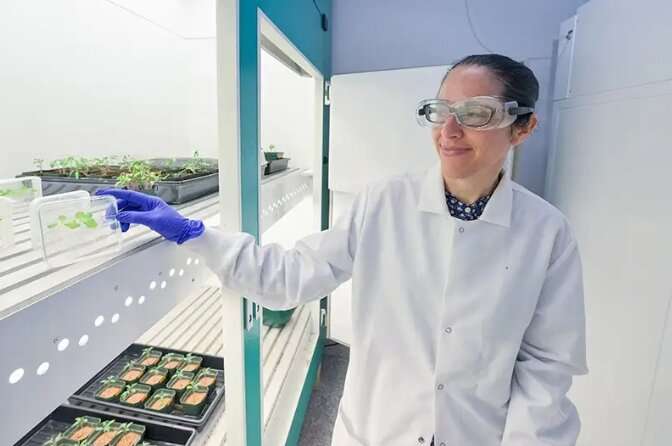This article has been reviewed according to Science X's editorial process and policies. Editors have highlighted the following attributes while ensuring the content's credibility:
fact-checked
trusted source
proofread
Beneficial bacteria a double-edged sword

Alfalfa, also known in Latin as Medicago sativa, is an agricultural crop that is part of the legume family. It is known as a protein-rich food source for dairy cattle that is easily digested and can lead to increased milk production. This is good news if you are a fan of ice cream or other dairy products.
However, alfalfa can be susceptible to common fungal diseases, such as spring black stem or root rot, that can limit crop yields.
A recent paper published in Plants by University of Delaware plant biologist Harsh Bais and postdoctoral researcher Amanda Rosier has shown that UD1022, a UD-patented beneficial bacteria, can protect alfalfa plants from fungal pathogens that cause plant disease.
The UD-patented microbe UD1022 is a unique strain of Bacillus subtilis, a natural, beneficial bacterium that lives on the surface of roots and the surrounding soil, or rhizosphere. UD1022 is known as a growth promoter that can help plants flourish vigorously. It also is considered a plant protector for its ability to help plants wage a system-wide resistance when under attack by one of these microscopic disease agents.
Rosier, the paper's lead author, knew through previous work that UD1022 was beneficial to legumes, such as peas and lentils. She wondered if UD1022 would help alfalfa fend off common fungal diseases. So, she challenged four different fungal pathogens with UD1022 in the laboratory to see if it prevented the fungus from infecting the alfalfa. It did.
Rosier said she thought it was because Bacillus subtilis like UD1022 produce a molecule known as surfactin, which acts as an antibiotic, enhancing the plant's fungal resistance. To test this theory, she removed the gene in UD1022 that produces this antibiotic, then retested the modified UD1022 bacteria and the fungus strains. Rosier found that without the gene to produce surfactin, UD1022 lost the capability to work as a broad-spectrum antifungal. Further experiments showed that biofilms—thick, sugary coatings that help microbes stick to plants—also play a role in UD1022's ability to suppress alfalfa fungal pathogens in some species.
This is good news and could pave the way for additional plant and field studies to understand this antagonistic behavior.
However, Rosier and Bais discovered that not all of UD1022's attributes are universally beneficial. Indeed, it looks like UD1022's relationships can be complicated, and the notorious helper of plants might even have a dark side.

Unfriendly to friends, as well as foes
UD1022 lives on the surface of plant roots where it can help promote plant growth. It has been shown to be particularly helpful for some legumes that interact with rhizobium, a good bacterium that forms special relationships with plants in the pea and lentil family.
Rhizobium bacteria live inside nodules on the plant's roots and fix atmospheric nitrogen, an essential nutrient critical for plant growth that is typically hard to access. It's a symbiotic relationship where plants get nitrogen to feed on and the bacteria gets a home.
UD1022 has been licensed by BASF and incorporated into four commercial products already in the market and sold in the U.S. and Canada. One successful commercial product, called Nodulator Duo, is sold and used in the U.S. and Canada to promote nitrogen fixation and plant health in peas and lentils.
In earlier work, Rosier showed that nodule-forming bacteria such as rhizobium use a type of communication called quorum sensing, where signaling molecules call like cells in its community and tell them to colonize the plant roots and help fix nitrogen.
The research team theorized that since UD1022 was known to be so helpful in some lentil-rhizobium interactions, it might also benefit this association in alfalfa by promoting root growth and giving more surface area for the rhizobium to grow.
"But when Amanda did this experiment, we actually saw a negative result," said Bais. Instead of helping, UD1022 somehow hurt the association between the plant and rhizobium, and the plants did not do well. That work showed that UD1022 can silence these signaling molecules effectively by interrupting this communication.
This caused Rosier to dig a little deeper (yes, a soil pun) to parse out these bacteria-bacteria interactions between rhizobium and UD1022. The research team knew that rhizobium bacteria secrete chemicals to encourage more bacteria to colonize the root. When Rosier added UD1022 directly to the rhizobium bacteria without the plant, it was not able to grow.

In a Plant Methods paper published last fall, Rosier described a method for visualizing this "quorum sensing" with the naked eye, using a tool called a biosensor to detect these communication-signal molecules. When the biosensor detected that communication-signaling molecules were present on a petri dish, it turned blue. The greater and darker the amount of blue, the more communication signals were present. Less blue meant fewer communication signals.
When she added rhizobium to the alfalfa plant, Rosier observed a nice blue spot at the plant root surface. But when Rosier put both the rhizobium and the UD1022 together, the blue spot almost completely disappeared. UD1022 was secreting a molecule that interrupted the messaging the rhizobium bacteria was sending to bring its own kind to colonize the plant roots to help the plant grow. This placed the plant at increased risk because it was not able to fix nitrogen properly.
"So, we have this beneficial bacteria UD1022, that in some cases, may not be as beneficial as we want it to be, so we must be careful about how we apply it," said Rosier.
Not a one-size-fits-all
Together, the two papers illustrate the diverse range of functional response with plant growth-promoting bacteria, such as UD1022. It's not a one size fits all.
This is important information as agricultural industries move toward broad use of biostimulants to promote crop growth and yield. More study is needed to understand specifics on how and when to apply these beneficial bacteria in the field, Rosier said. For instance, maybe it makes best sense to apply rhizobium first to help with growth, and then apply UD1022 later for pest control.
Additionally, Bais said, understanding UD1022's ability to interrupt communication signals in pathogens could have human health applications, too. For example, people with cystic fibrosis are immunocompromised, placing them at increased risk for hospital-acquired bacteria, such as pneumonia. Pneumonia also is a bacterium that uses quorum sensing to form films in the lungs, causing breathing difficulty.
"A lot of human pathogens use the same strategy to cause virulence or infection," said Bais. "Understanding how UD1022 severs the signaling molecules responsible for creating the film could provide clues to new treatment approaches for keeping patients healthier."
More information: Amanda Rosier et al, Surfactin and Spo0A-Dependent Antagonism by Bacillus subtilis Strain UD1022 against Medicago sativa Phytopathogens, Plants (2023). DOI: 10.3390/plants12051007
Provided by University of Delaware




















